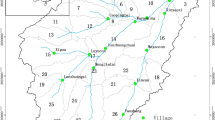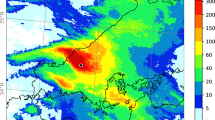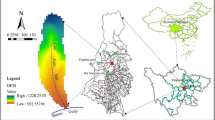Abstract
Debris flows have caused serious human casualties and economic losses in the regions strongly affected by the Ms8.0 Wenchuan earthquake of 2008. Debris flow mitigation and risk assessment is a key issue for reconstruction. The existing methods of inundation simulation are based on historical disasters and have no power of prediction. The rainflood method can not yield detailed flow hydrograph and does not meet the need of inundation simulation. In this paper, the process of water flow was studied by using the Arc-SCS model combined with hydraulic method, and then the debris flow runoff process was calculated using the empirical formula combining the result from Arc-SCS. The peak discharge and runoff duration served as input of inundation simulation. Then, the dangerous area is predicted using kinematic wave method and Manning equation. Taking the debris flow in Huashiban gully in Beichuan County, Sichuan Province, China on 24 Sep. 2008 as example, the peak discharge of water flow and debris flow were calculated as 35.52 m3·s−1 and 215.66 m3·s−, with error of 4.15% compared to the measured values. The simulated area of debris-flow deposition was 161,500 m2, vs. the measured area of 144,097 m2, in error of 81.75%. The simulated maximum depth was 12.3 m, consistent with the real maximum depth between 10 and 15 m according to the field survey. The minor error is mainly due to the flow impact on buildings and variations in cross-section configuration. The present methodology can be applied to predict debris flow magnitude and evaluate its risk in other watersheds inthe earthquake area.
Similar content being viewed by others
Reference
Aleotti P (2004) A warning system for rainfall-induced shallow failures. Engineering Geology 73:247–265.
Berti M, Simoni A (2005) Experimental evidences and numerical modelling of debris flow initiated by channel runoff. Landslide 2: 171–182.
Bisson M, Favalli M, Fornaciai A et al. (2005) rapid method to assess fire-related debris flow hazard in the Mediterranean region: An example from Sicily (southern Italy). International Journal of Applied Earth Observation and Geoinformation 7: 217–231.
Brater EF, King HW (1976) Handbook of hydraulics for the solution of hydraulic engineering problems. New York: McGraw Hill Book Company.
Cui P (1992) Study on condition and mechanisms of debris flow initiation by means of experiment. Chinese Science Bulletin 37(9): 759–763.
Cui P, Chen XQ, Zhu YY et al. (2009) The Wenchuan Earthquake (May 12, 2008), Sichuan Province, China, and resulting geohazards. Natural Hazards doi:10.1007/s11069–009-9392-1.
Cui P, Zhuang JQ, Chen XZ et al. (2010) Characteristics and countermeasures of debris flow in Wenchuan area after the Earthquake. Journal of Sichuan University (Engineering Science Edition) 42(5): 10–19. (In Chinese).
Hu KH, Cui P, Wang CC et al. (2010) Characteristic rainfall for warning of debris flows. Journal of Mountain Science 3:207–214.
Hu KH, Wei FQ, He YP et al. (2003) Application of particle model in risk zoning of debris flows. Journal of Mountain Sciences 21(6): 726–730. (In Chinese).
Iverson RM (1997) The physics of debris flow. Reviews of Geophysics 35(3): 245–296
Kang ZC, Li ZF, Ma AN et al. (2004) Study on debris flows in China. Beijing: Science press 54–55. (In Chinese).
Liu JF, You Y, Chen XZ et al. (2010) Identification of potential sites of debris flows in the upper Min River drainage, following environmental changes caused by the Wenchuan earthquake. Journal of Mountain Science 3:255–263.
Montes S (1998) Hydraulics of open channel flows. Reston: ASCE Press, pp 1–697.
SCS (Soil Conservation Service) (1972) SCS National Engineering Handbook, Section 4. Hydrology, Soil Conservation Service. US Department of Agriculture, Washington, DC.
Sichuan Water and Power Department (1984) Sichuan Hydrology Record Handbook, pp 2–36.
Tang C, Zhu J, Li WL et al. (2009) Rainfall-triggered debris flows following the Wenchuan earthquake. Bulletin of Engineer Geology Environment 68:187–194 doi:10.1007/s10064-009-0201-6.
Wang G, Shao S, Fei X (1997) Particle model for alluvial fan formation. In: Chen, CL (ed.), Debris flows Hazard Mitigation: Mechanics, Prediction, and Assessment, Proceeding of the First International DFHM Conference, San Francisco, CA, USA, August 7–9. New York: ASCE, pp 143–152.
Wang GQ, Song SD, Fei XJ (1998) Debris flow simulation:Imodel. Journal of Sediment Research 43(3): 7–131. (In Chinese).
Wei FQ, Hu KH, Lopez JL et al. (2003) Method and its application of the momentum model for debris flow risk zoning. Chinese Science 48(3): 298–301.
Wu JS, Tian LQ, Kang ZC et al. (1993) Debris flow and its comprehensive control. Beijing: Science Press pp 17–191. (In Chinese).
Xie H, Du J K, Hu Y J et al. (2005). Study on sSpatially distributed hydrological model based on routing time method. Journal of Wwuhan Uuniversity of Ttechnology 27: 75–78. (In Chinese).
Yu FC, Chen CY, Chen TC etal. (2006) A GIS process for delimitating areas potentially endangered by debris flow. Natural Hazards 37:169–189.
Author information
Authors and Affiliations
Corresponding author
Rights and permissions
About this article
Cite this article
Cui, P., Hu, K., Zhuang, J. et al. Prediction of debris-flow danger area by combining hydrological and inundation simulation methods. J. Mt. Sci. 8, 1–9 (2011). https://doi.org/10.1007/s11629-011-2040-8
Received:
Accepted:
Published:
Issue Date:
DOI: https://doi.org/10.1007/s11629-011-2040-8




